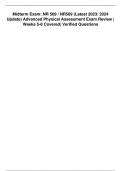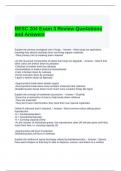-
1. Study guide - Nr 509 all quizzes week 1 to 7 advanced physical assessment 2019
-
2. Exam (elaborations) - Nr 509 week 3 quiz and answers latest graded a
-
3. Exam (elaborations) - Nr 509 week 4 quiz
-
4. Study guide - Nr 509 -test-bank chapter 2 physical examination & health assessment by jarvis: 7th e...
-
5. Exam (elaborations) - Nr 509-test-bank (chapter 21) physical examination & health assessment by jarvis: 7th...
-
6. Exam (elaborations) - Nr509 / nr 509 week 4 midterm exam.latest update
-
7. Exam (elaborations) - Nr509 / nr 509 week 5 exam.latest update
-
8. Exam (elaborations) - Nr 509 week 1 exam.latest update
-
9. Study guide - Nr 509 final exam study guide (2020): chamberlain college of nursing
-
10. Exam (elaborations) - Nr 509 final exam study guide.
-
11. Exam (elaborations) - Nr 509 all quizzes week 1 to 7 advanced physical assessment chamberlain spring
-
12. Exam (elaborations) - Nr509 / nr 509 midterm exam (latest 2022 / 2023): advanced physical assessment - cham...
-
13. Exam (elaborations) - Nr509 / nr 509 midterm exam (latest 2022 / 2023): advanced physical assessment - cham...
-
14. Exam (elaborations) - Nr 509 final (latest 2022 / 2023): advanced physical assessment - chamberlain
-
15. Exam (elaborations) - Nr 509 week 1
-
16. Exam (elaborations) - Nr 509 week 1
-
17. Exam (elaborations) - Nr 509 final exam
-
18. Exam (elaborations) - Nr 509 midterm
-
19. Exam (elaborations) - Nr509 / nr 509 midterm exam (latest ): advanced physical assessment - chamberlain
-
20. Exam (elaborations) - Nr509 / nr 509 midterm exam (latest 2021 / 2022): advanced physical assessment - cham...
-
21. Exam (elaborations) - Nr509 / nr 509 final exam (latest ): advanced physical assessment – chamberlain 130...
-
22. Exam (elaborations) - Nr509 / nr 509 week 2 quiz (latest): advanced physical assessment - chamberlain
-
23. Exam (elaborations) - Nr509 / nr 509 week 3 quiz (latest): advanced physical assessment - chamberlain
-
24. Exam (elaborations) - Nr509 / nr 509 week 3 quiz (latest): advanced physical assessment - chamberlain
-
25. Exam (elaborations) - Nr509 / nr 509 week 5 quiz (latest): advanced physical assessment - chamberlain
-
26. Exam (elaborations) - Nr509 / nr 509 week 4 quiz (latest): advanced physical assessment - chamberlain
-
27. Exam (elaborations) - Nr509 / nr 509 week 3 quiz (latest): advanced physical assessment - chamberlain
-
28. Exam (elaborations) - Nr509 / nr 509 final exam (latest): advanced physical assessment - chamberlain
-
29. Exam (elaborations) - Nr509 / nr 509 final exam (latest): advanced physical assessment - chamberlain
-
30. Exam (elaborations) - Nr509 / nr 509 midterm exam 2023 /2024: advanced physical assessment - chamberlain n...
-
31. Exam (elaborations) - Nr 509 week 4 quiz test bank questions
-
32. Exam (elaborations) - Exam final week 5 (elaborations) nr 509 abdomen and gu
-
33. Exam (elaborations) - Nr509 / nr 509 week 7 exam (latest 2023 / 2024): advanced physical assessment - chamb...
-
34. Exam (elaborations) - Nr 509-week 5 quiz 2023/2024
-
35. Exam (elaborations) - Nr509 / nr 509 week 6 exam (latest 2023 / 2024): advanced physical assessment - chamb...
-
36. Exam (elaborations) - Nr509 / nr 509 final exam (latest 2023 / 2024): advanced physical assessment - chambe...
-
37. Exam (elaborations) - Nr509 / nr 509 final exam (latest 2023 / 2024): advanced physical assessment - chambe...
-
38. Exam (elaborations) - Nr509 / nr 509 midterm exam (latest 2023 / 2024): advanced physical assessment
-
39. Exam (elaborations) - Midterm exam: nr 509/ nr509 advanced physical assessment midterm practice questions w...
-
40. Exam (elaborations) - Final exam: nr 509/ nr509 advanced physical assessment final exam practice questions ...
-
41. Exam (elaborations) - Midterm exam: nr 509/ nr509 advanced physical assessment (2024/ 2025 update)- chamber...
-
42. Exam (elaborations) - Final exam: nr 509/ nr509 advanced physical assessment (2024/ 2025 update)- chamberla...
-
43. Exam (elaborations) - Midterm exam: nr 509/ nr509 advanced physical assessment midterm practice 177 questio...
-
44. Exam (elaborations) - Final exam: nr 509/ nr509 advanced physical assessment final practice questions with ...
-
45. Exam (elaborations) - Final exam: nr 509/ nr509 advanced physical assessment final practice questions with ...
-
46. Exam (elaborations) - Final exam: nr 509/ nr509 advanced physical assessment final practice questions with ...
-
47. Exam (elaborations) - Nr 509/ nr509 advanced physical assessment exam practice questions with verified answ...
-
48. Exam (elaborations) - Nr 509/ nr509 advanced physical assessment exam practice questions with verified answ...
-
49. Exam (elaborations) - Nr 509/ nr509 module 5 advanced physical assessment
-
50. Exam (elaborations) - Nr 509 mid-term study 240 questions and answers . 2024/25
-
51. Exam (elaborations) - Midterm exam: nr 509/ nr509 advanced physical assessment midterm exam questions with ...
-
52. Exam (elaborations) - Nr 509 week 1 questions with verified answers (latest 2023/ 2024)
-
53. Exam (elaborations) - Midterm exam: nr 509 / nr509 | latest 2023-2024 | advanced physical assessment exam| ...
-
54. Exam (elaborations) - Midterm exam: nr 509 / nr509 (latest 2023/ 2024 update) advanced physical assessment ...
-
55. Exam (elaborations) - Midterm exam review: nr 509 / nr509 | latest 2023-2024 |advanced physical assessment ...
-
56. Exam (elaborations) - Midterm exam: nr 509/ nr509 advanced physical assessment midterm exam questions with ...
-
57. Exam (elaborations) - Final exam: nr 509 / nr509 (latest 2023/2024) advanced physical assessment exam| alre...
-
Show more





